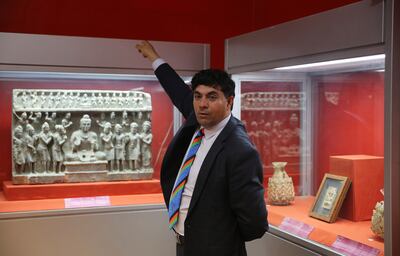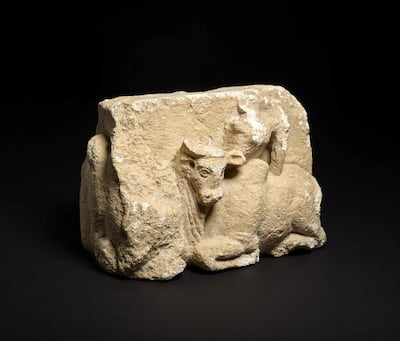The Taliban moved into Kabul on August 15 with a speed that caught the city by surprise. Mohammad Fahim Rahimi, director of the National Museum of Afghanistan, quickly sealed the building. With police presence, he asked two staff to stay.
Rahimi stayed up through the night, fielding calls and messages on his two phones. In the morning, when it was clear the museum had neither been attacked nor looted, he allowed himself to relax a little. He used his contacts to find pro-Taliban people to guard the site, and two days later, asked local Taliban members to provide security, which is ongoing.
“It was the worst day of my life,” he says. “I wish it never happens again. I felt the responsibility for the museum: that I should take care of it, and that I should not leave it. I was ready to give my life for it.”

And he had reason to fear the worst for the museum. During the first Taliban takeover of Afghanistan in 1996, an estimated 70 per cent to 80 per cent of the National Museum’s holdings were either looted or destroyed, amounting to about 160,000 objects. Buddhist sculptures from the monasteries in Hadda lay smashed to pieces; carved ivories were snatched from within broken display cabinets. And about 90 per cent of its records were burnt, severely hampering recovery processes.
Since then, and particularly from 2009 onwards, a large priority for the institution has simply been to recoup these losses, in partnership with customs agents, other museums and cultural organisations worldwide.
The museum has now received about 35,000 objects, a figure that includes the restitution of looted works as well as those that had been illegally excavated during the turmoil of the 1990s. According to Rahimi, about 15,000 objects were returned from different countries; about 10,000 were confiscated by security forces inside Afghanistan; and the remaining 10,000 were those that had been illegally excavated and are now housed in the museum.
While many of these are smaller pieces, the museum has been successful in bringing back some more significant works, such as a large second-century Buddha statue and first-century Bagram ivories, part of a notable tranche of works returned with the help of the British Museum in 2012.

However, Rahimi’s goals surpass plain recovery. Since he was appointed director in 2016, he has been ambitiously planning to increase the museum’s reach, both within Kabul and beyond. It began with the long-running scheme to expand the museum’s principal site, a building originally designed as administrative offices.
In 2012, Spanish company AV 62 Arquitectos won a competition for a 9,300-square-metre extension, arranged in a series of rounded arched corridors, that would provide climate-controlled space for the museum’s fragile artefacts. This design phase of the project was nearly finished: in June the architectural firm even announced its completion.
Rahimi's second, larger idea was to set up a network of provincial museums that would recognise and celebrate the richness and diversity of Afghanistan’s cultural heritage. A trial run (of sorts) of this project was already successful. Working with the Oriental Institute of the University of Chicago, the National Museum developed the Mobile Museum Project, which brought 3D replicas of artefacts from the Kabul museum to schools across the country. The artefacts toured from 2013 to 2016 to Kabul, Herat, Mazar-e-Sharif, Bamiyan, Kandahar, Jalalabad and elsewhere.
Just getting these ideas off the ground, in the security and economic circumstances of Afghanistan, had been a feat in itself.
“I worked closely with the government here, and of course there were a lot of challenges,” says Rahimi. “There are not a lot of funds, but also not a lot of understanding of what I’m talking about. But I knew that the country is also in a situation of war and I could not blame them.
“Now I don’t know if we will be able to follow those dreams, those plans that I had,” he says.
Rahimi studied archaeology at Kabul University and began working for the museum two years after graduating. He is in his thirties and has already played an important role at the museum.
As chief curator under the previous director, Omara Khan Masoudi, he led in many of the restitution cases, liaising with international bodies and speaking worldwide to raise awareness of the importance of recovery. (His role as international liaison was partially because, as he put it with the warm weariness of someone under 40, Masoudi “did not have much access to the internet or email”.) On a Fulbright scholarship, he got a master’s in cultural heritage preservation at the University of Pennsylvania, the Ivy League college in Philadelphia, where he focused on the specific threat to Afghan museums and sites.
When the Taliban advanced on Kabul this year, his international contacts called and texted, offering him ways out of the country, but Rahimi refused. He is not particularly optimistic about the prospects in Afghanistan, but says he will stay on the off-chance that the Taliban allow for freedom in the museum’s working conditions. If he is unable to continue, he will pursue a PhD outside the country.
“If I raise my education I can better serve my country when the situation improves,” he says. “But that’s only the second plan. If I have the opportunity, my primary plan is to stay here and work with the museum and preserve it.”






